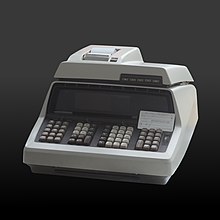
The Hewlett-Packard 9100A (HP 9100A) is an early programmable calculator (or computer), first appearing in 1968. HP called it a desktop calculator because, as Bill Hewlett said, "If we had called it a computer, it would have been rejected by our customers' computer gurus because it didn't look like an IBM. We therefore decided to call it a calculator, and all such nonsense disappeared."
An ad for the 9100A in 1968 Science magazine contains one of the earliest documented use (as of 2000) of the phrase personal computer.
History

The unit was descended from a prototype produced by engineer Thomas "Tom" E. Osborne, who joined the company when HP decided to adopt the project.
An engineering triumph at the time, the logic circuit was produced without any expensive integrated circuits, the assembly of the CPU having been entirely executed in cheaper discrete components. With CRT readout, magnetic card storage, and printer, the price was around US$4,900 (equivalent to $43,000 in 2023).
Thanks to its high speed of operations which was an order of magnitude faster than competitors – addition or subtraction took just 2 ms, multiplication 22 ms and division 27 ms – the device could quickly execute not just regular trigonometric functions (330 ms) or logarithms (130 ms) but many iterative computations when following a program. This made the 9100A the first scientific calculator by the modern definition, and also marked the beginning of Hewlett-Packard's long history of using Reverse Polish notation (RPN) entry on their calculators.
Due to the similarities of the machines, Hewlett-Packard was ordered to pay about $900,000 in royalties to Olivetti after copying some of the features adopted in the Programma 101, like the magnetic card and the architecture.
See also
References
- ^ "History of the 9100A desktop calculator, 1968". Hewlett-Packard. Retrieved 2009-12-18.
- ^ Aaron, Clark (Dec 2000). "Wired 8.12: Must Read: The First PC". Archived from the original on 2015-10-04. Retrieved 2015-10-04.
- See Old Calculator Museum definition at the end of cited page (note with asterisk)
- "Note in: WANTED - Data Acquisition Corp. DAC-512". www.oldcalculatormuseum.com. Note with asterisk at the end.
- "Osborne's Story". HP9825.com. Retrieved 2010-05-11.
- "How the Model 9100A Was Developed", Bernard M. Oliver, September 1968, Hewlett-Packard Journal]
- 1994 letter from Tom Osborne to Barney Oliver, hp9825.com
- Monoskop/Whole Earth (1968). "9100A Calculator". Whole Earth Catalog (fall 1968), no. #1010. p. 34. Retrieved 2023-10-27.
- "The 9100 Part 2". www.hp9825.com. Retrieved 2024-01-14.
- "HP9100". hpmemoryproject.org. Retrieved 2024-01-14.
- "Olivetti Programma P101/P102". Old Computers. Archived from the original on 2016-06-09. Retrieved 2010-08-11.
The P101, and particularly the magnetic card, was covered by a US patent (3,495,222, Perotto et al.) and this gave to Olivetti over $900.000 in royalties by HP alone, for the re-use of this technology in the HP9100 series.
- Perotto, Pier Giorgio (1970-02-10). "3,495,222 Program Controlled Electronic Computer" (multiple). United States Patent and Trademark Office. et al. Google patents. Retrieved 2010-11-08.
External links
- "HP 9100A Calculator (marketing brochure)" (PDF). Hewlett-Packard. 1968. Retrieved 2013-01-26. Hosted at the Computer History Museum.
- "HP 9100A/B". The Museum of HP Calculators. Retrieved 2013-01-26.
- Bell, C. Gordon; Newell, Allen (1971). "Chapter 20: The HP Model 9100A computing calculator". Computer Structures: Readings and Examples. McGraw-Hill. p. 243. ISBN 0-07-004357-4. Retrieved 2009-12-18.
- Steven Leibson interview of Tom Osborne
| Hewlett-Packard (HP) calculators | |
|---|---|
| Graphing | |
| Scientific programmable | |
| Scientific non-programmable | |
| Financial and business | |
| Other | |
| Related topics | |
| Emulation software | |
This computer hardware article is a stub. You can help Misplaced Pages by expanding it. |